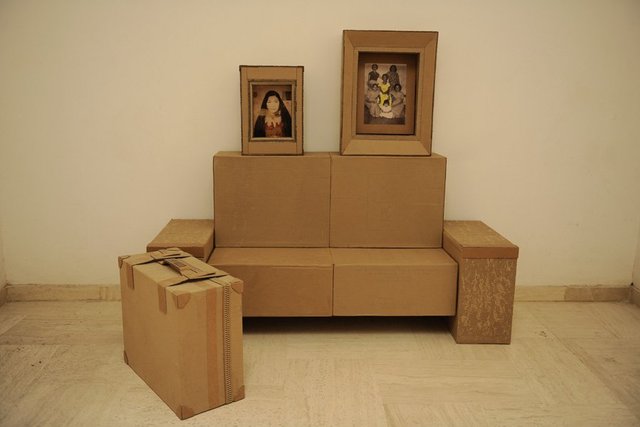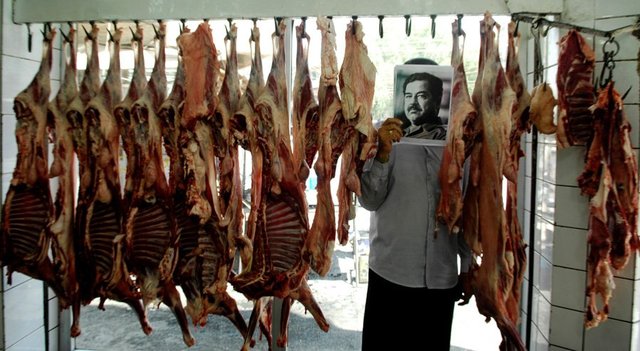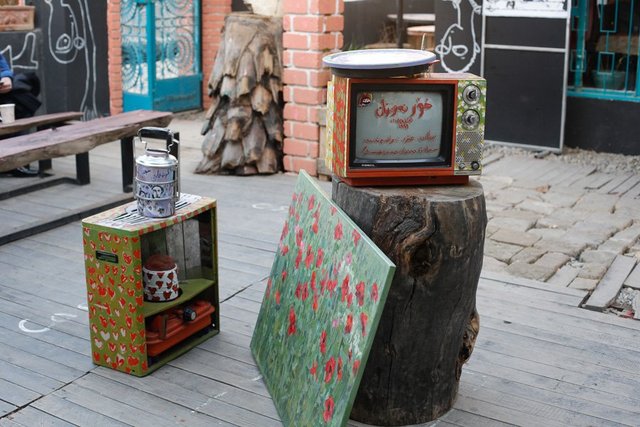Interviews
A DREAM: The Iraq Pavilion at 55th Venice Biennale
Tamara Chalabi, Reem Shather-Kubba, and Jonathan Watkins in conversation with Basak Senova
This year's Iraq Pavilion at the 55th Venice Biennale takes place at Ca' Dandolo. Under the curatorship of Jonathan Watkins, the pavillion, titled Welcome to Iraq, was commissioned by the Ruya Foundation. It takes an opposite turn from the 2011 Iraq Pavilion, curated by Mary Angela Schroth under the theme 'Acqua ferita' (wounded water), presenting six artists of the Iraqi diaspora: Adel Abidin, Ali Assaf, Azad Nanekeli, Walid Siti, Ahmed Alsoudani, and Halim El-Karim. By contrast, the 2013 pavillion presents eleven artists living and working inside the country: Jamal Penjweny, Abdul Raheem Yassir, Bassim Al-Shaker, Cheeman Ismaeel, Kadhim Nwir, Furat al Jamil, WAMI (Yaseen Wami, Hashim Taeeh), Akeel Khreef, Ali Samiaa and Hareth Alhomaam.
In this multi-part interview, Basak Senova talks with Tamara Chalabi and Reem Shather-Kubba, founding members of Ruya Foundation for Contemporary Culture in Iraq, and Jonathan Watkins. It traces the motivation, diverse realities and the aspirations of the Iraqi Pavilion.
PART 1
A conversation with Tamara Chalabi
Basak Senova: What does the participation of Iraq to Venice Biennale mean to you?
Tamara Chalabi: I am a great believer in soft power, the power of communication through people, and something like the Venice Biennale is a very important affirmation of life and hope for Iraqis and for art in Iraq. It is with projects like the Iraq Pavilion that it's possible to open the eyes of people to some of what's going on inside the country (other than the terrible news they hear about), but also to open the gates for artists inside the country to see the outside world, to allow them to dream and aspire for better things and a better life.
BS: Do you think the Iraqi Pavilion could trigger a change in the Iraqi society? At least for the circles or educational bodies who are connected to arts and culture?
TC: I would prefer to call it a shift. Change takes a long time to happen, and this is one step in the right direction. I hope it will increase awareness among those connected to arts and culture, especially artists, and help them better understand what is going on in contemporary art in the rest of the world.
BS: How do you locate the Iraqi contemporary art in the international map of the art scene?
TC: There was a relatively advanced art scene in Iraq in the sixties and seventies, but since then, with few exceptions, there has been somewhat of a stagnation. I think there is potential and talent, but it has to be nurtured properly and given the right support.
BS: Could you explain what you mean by 'right support'?
TC: Right support means support, whether from the government, from the private sector, from universities and cultural organisations, addressing key matters, such as the shortages that exist within, whether through education, exposure to art in the wider scene, ability to travel even to visit the great museums that many take for granted, opportunities to interact with artists outside, critical feedback, even access to good art material.
BS: How do you see the relationship between the international collectors and the Iraqi artists along with the new initiatives from Iraq?
TC: I think that there is a lot of potential, but it still needs time for artists to find their voices. While collectors may be keen on collecting art from inside Iraq, it might be interesting to first watch and follow for a while. In many instances, they may do a disservice to the art scene by getting involved too quickly, when that art scene may still need time to develop and mature more. If artists see that there is a market for their work immediately, they will keep producing it, and perhaps not questioning it or seeking to improve. This has certainly been the case in other countries in the same phase of artistic development.
BS: What is different from the last (and the first) edition of the Iraq Pavilion at Venice compared to this year's edition?
TC: The last Iraq pavilion represented Iraqi artists from the diaspora. That is also part of Iraq's reality: over 4 million living abroad, over a stretch of several decades. Many of them are internationally recognised artists. The first edition in 1976, from what literature I have seen, was a traditional showcase of Iraq's leading abstract artists. It was state sponsored, and didn't have a specific theme.
PART 2
A conversation with Reem Shather-Kubba
BS: In 2011, the Iraq Pavilion presented artists living abroad. Could you elaborate your focus to the Iraqi Diaspora?
Reem Shather-Kubba: In the 54th Venice Biennale, the Iraq Pavilion returned to Venice after a 35 year hiatus with an exhibition focused on 6 Iraqi artists living in the Diaspora, some of whom are internationally acclaimed. It was a very powerful and well-received pavilion. By contrast, this time around, the focus has been very much on those Iraqis living and working within the length and breadth of Iraq. This Pavilion will be in stark contrast not only in terms of the artists exhibiting but the venue and the themes of the exhibition.
BS: How do you compare and read the significance of the last and first Iraqi pavilion with the curatorial approach of Jonathan Watkins for this year?
RSK: Jonathan has been instrumental in setting the tone of this year's Iraq Pavilion. From the title of this Pavilion, Welcome to Iraq, I think the audience will be encouraged to go inside and 'take a look', and while it would seem they may be met with the predictability of destruction and chaos that is present day Iraq, what they will actually faced with is quite the opposite.
Despite the ravages of war, Iraq's artists have still managed to find their voices and push the boundaries of their craft and I think Jonathan has been very keen to show this strength to a wider audience. I believe that the end result is a celebration of a resilient, brave, dignified and hopeful pavilion.
BS: What was the local outcome of the previous Venice Biennale for you? Was the international reception of the pavilion then totally different?
RSK: I feel that the last pavilion was a success and very confident step in the right direction, ensuring the world sat up and took note of Iraqi contemporary art. The selected artists of this first pavilion (some whom are internationally acclaimed) all live in the diaspora and our objective after a 35 year absence at Venice was to simply say 'we're back.' Of course as with everything in life, there will always be some element of constructive criticism and without it, we don't learn to push forward and develop. Nevertheless, it was a pavilion I look back on with great fondness both for the artists who exhibited and for the committee who were instrumental in bringing it to fruition.
PART 3
A conversation with Jonathan Watkins
BS: How did you become involved with the Iraq Pavilion at the 55th Venice Biennale?
Jonathan Watkins: I had never been to Iraq before my appointment as curator of the Iraq Pavilion, and I wouldn't call myself an expert on Iraqi art by any stretch of the imagination. I have worked in Palestine and also I was a curator for the 2007 Sharjah Biennial, but the UAE and Palestine are very different places, and again nothing like Iraq. My interest in the Middle East arts scene has evolved over the years. I first showed a Palestinian artist, Khalil Rabah, in the 1998 Sydney Biennale, which I curated. And Iraq? I was invited by the Ruya Foundation to curate to Iraq Pavilion, and feel very lucky. My job is to make the best exhibition I can out of work now being made by artists in Iraq, a place more or less without cultural infrastructure.
BS: Could you describe the selection process and how you decided on showing artists specifically living in Iraq?
JW: The previous Iraq Pavilion in Venice – incidentally, the first since the 1970s – featured only artists from the diaspora. In response I thought that it would be good to present a selection of work by artists living and working inside Iraq. I made several trips there, travelling across the country to meet people from various (art and non-art) communities. This research was absolutely integral to the curatorial process, whereby I quickly got an overview and then, through making studio visits, began to develop more definitive ideas. Above all, I wanted to show artists whose work exemplified a proposition that evolved out of my experience in Iraq, rather than illustrate one that had previously occurred to me.
BS: How do you think your research on Iraq-based artists will translate when shown in the context of the Venice Biennale?
JW: Iraq at present is a place more or less without cultural infrastructure. Certainly there are no 'go-to' curators or critics in Baghdad or Basra or Erbil to provide guidance, and very few on the outside know anything about what is happening art-wise inside the country. In other words, our research means that thousands of people will go to Venice this year and see work from Iraq they could never have seen before.
I hope very much that what we have done will encourage others to find out more and help with what is already happening Iraq. A translation of our research simply into commercial interest would be counterproductive. Above all, it would be nice to think that our audiences in general will be impressed by how resilient the Iraqi people are.
BS: Does the pavilion have a specific theme?
JW: Our exhibition is about how life is lived inside Iraq, every day, rather than reiterating all-too-familiar arguments about geopolitics. Millions of people get up in Iraq every day, make breakfast, get their children ready for school, go to work or not, have lunch, go shopping, meet friends, have dinner, watch TV, get ready for bed and so on ... A small percentage of a small percentage might come to some harm through a violent act of terrorism, but normally, for the vast majority, the daily round is a question of 'making do and getting by'. The artwork we are showing embodies inventiveness borne out of necessity in very difficult circumstances.
BS: Does the pavilion support the theme of The Encyclopaedic Palace, which was developed by Venice Biennale curator Massimiliano Gioni'?
JW: Well, a Biennale with art from Iraq will be more encyclopaedic than one without it!
Also, like Gioni, we are not so hung up on art and similarly value found objects and artefacts. The Iraq Pavilion itself is an extraordinary found object: an apartment on the Grand Canal in which visitors can relax while drinking (Iraqi) tea and reading books (on Iraq). The exhibited work is inextricably bound up with this context.
Tamara Chalabi is a historian, published author and writer on cultural affairs. She received her BA from Brown University in the US, her MPhil from Cambridge University in the UK and a PhD in History from Harvard University in the US in 2003. She is the author of two books, The Shi'is of Jabal'Amil and the New Lebanon: 1918-1943, published by Palgrave Macmillan in 2006 (translated into Arabic and published by the Dar Al-Nahar Press) and Late for Tea at the Deer Palace; the Lost Dreams of my Iraqi Family, published by HarperCollins in 2010 (translated into several languages). She has alsowritten for various UK and US publications; the Sunday Times, New Republic, Wall Street Journal, Slate, Conde Nast Traveler and Prospect on war, culture, encounters and identities. She is also a co-founder, and the chairman of Ruya Foundation for Contemporary Culture in Iraq, an organization that is committed to promoting Iraqi art and culture internationally.
Reem Shather-Kubba is a trained solicitor of the Supreme Court of England and Wales. Shather-Kubba read International Relations at the University of Leeds and received her post graduate diploma in Law at the College of Law, London. After working at international law firms in London and Dubai, she served as in-house counsel for luxury hotel, resort and hospitality company Jumeirah Group. Shather-Kubba focused her interest on contemporary Middle Eastern art and philanthropic endeavours. Active in both collecting art and supporting new art initiatives, she has worked on several projects related to Iraq from organising a group exhibition of Iraqi artists in exile, "They Welcomed Us With Flowers" at the Bastikya Art Fair in Dubai, to serving as co-chair of the Patrons Committee for the Iraq Pavilion, Venice Biennale 2011. Shather-Kubba is also an executive board member of SADA Iraq, a non-profit project supporting new and emerging arts practices through education initiatives in Iraq and public programs internationally.
Jonathan Watkins is an internationally renowned curator and writer who has been Director of Ikon Gallery, Birmingham, since 1999. Previous positions include Curator of the Serpentine Gallery (1995-1997) and Director of Chisenhale Gallery (1990-1995). He has curated a number of significant international exhibitions including the Guangzhou Triennial (2012); Negotiations , Today Art Museum, Beijing (2010); Sharjah Biennial (2007); Shanghai Biennale (2006); Tate Triennial (2003); Facts of Life: Contemporary Japanese Art, Hayward Gallery, London (2001); Quotidiana, Castello di Rivoli, Turin (1999); and the Biennale of Sydney (1998). He was part of the curatorial team for Riwaq: Palestinian Biennial (2007); Milano Europa 2000, Palazzo di Triennale, Milan; and Europarte, Venice Biennale (1997).
Participating artists of the Iraqi Pavilion in 2013
Abdul Raheem Yassir, (Gammas, Qadisiya, 1951. Lives and works in Baghdad). Abdul Raheem
Akeel Khreef (Baghdad, 1979, lives and works in Baghdad)
Ali Samiaa (Baghdad, 1980. lives and works in Baghdad)
Bassim Al-Shaker (Baghdad, 1986, lives and works in Baghdad)
Cheeman Ismaeel (Sulaimaniya, 1966, lives and works in Sulaimaniya)
Furat al Jamil (Mainz, 1965, lives and works in Baghdad)
Hareth Alhomaam (Baghdad, 1987, lives and works in Baghdad)
Jamal Penjweny (Sulaimaniya, 1981, lives and works in Sulaimaniya)
Kadhim Nwir (Qadisiyah, 1967, lives and works in Babylon)
WAMI [Yaseen Wami (Basra, 1973, lives and worksin Basra and Odessa), Hashim Taeeh (Basra, 1948, lives and worksin Basra)]
Ruya Foundation for Contemporary Culture in Iraq (RUYA) is an Iraqi registered non-profit, non-governmental organization founded in 2012 by Iraq art and culture enthusiasts with the aim of aiding and enriching culture in Iraq, and building cultural bridges with the world.


















